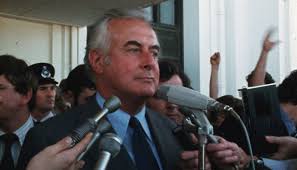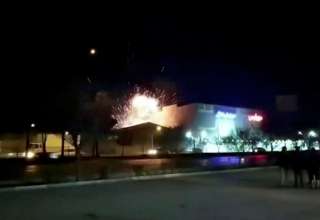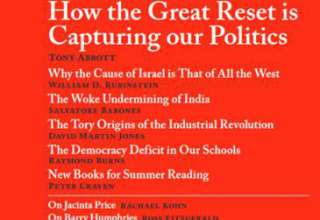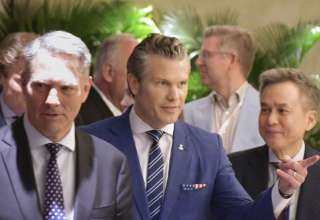by Bevan Ramsden *
This is not a conspiracy theory. The United States interference in Australia’s domestic politics was confirmed by no lesser person than the President of the United States, Jimmy Carter, in an apology to Gough Whitlam via the President’s envoy at a breakfast meeting in the Qantas lounge in 1977. Whitlam conveyed the substance of the meeting to the House in 1977 and it is recorded in Hansard.
The Whitlam government of 1972 to 1975 responded to a wave of progressive feeling and ushered in a new political era for Australia. Briefly Australia became an independent state.
Whitlam ended colonial servility.
He abolished Royal patronage, no Sir’s and Dames.
He moved Australia towards the non-aligned movement, supported zones of peace and opposed nuclear weapons testing.
Whilst not regards by his party as “of the left”, he was a maverick social democrat of principle.
He believed that a foreign power should not control his country’s resources or dictate its economic and foreign policies.
His Government gave diplomatic recognition to the People’s Republic of China.
His government drafted the first Aboriginal Lands Rights policy.
One of his first acts when elected was the ending of the National Service Act and conscription and released those who had been jailed for offences under that Act; in deed he personally went to the jail and shook hands with the first of those draft resisters when released. Of course he withdrew, the remnants of Australia’s troops from Vietnam as the US was doing also with its troops.
Whilst the ALP including Whitlam, did not publically endorse the Vietnam Moratorium anti-war movement, some of the senior members of his party who subsequently became ministers in his government, did. Tom Uren in Sydney was jailed at least once for his anti-conscription activities. Dr Jim Cairns led the massive moratorium marches in Melbourne where in May 1970, 100,000 committed civil disobedience in sitting down and blocking the roads and occupying the city in protest against the war.
After the election of the Whitlam Government, when some of his Ministers publically condemned the US bombing of North Vietnam as “corrupt and barbaric”,(John Pilger in “A Secret Country”, revealed that) Frank Nepp, CIA officer in Saigon at the time said: “We were told that the Australians might as well be regarded as North Vietnam collaborators”.
Whitlam knew the risks he was taking.
The day after his election, he ordered that his staff should not be “vetted” or “harassed” by ASIO.
He also demanded to know if and why the CIA was running a spy base at Pine Gap near Alice Springs, a giant “vacuum cleaner” which, as Edward Snowden revealed recently, allows the US to spy on everyone. Snowden also revealed that in the minutes of a meeting with the US Ambassador Mr Whitlam warned “Try and screw us or bounce us and Pine gap will become a matter of contention”.
Victor Marchetti, the CIA officer who helped set up Pine Gap, told me, says journalist John Pilger, “The threat to close Pine gap caused apoplexy in the White House…. and a kind of Chilean Coup was set in motion:”.
Joan Coxsedge in an article on Nugan Hand and the CIA and ousting of the Whitlam government states: “There was however, no statement of intent from Whitlam that his government intended to close Pine Gap. The Pine Gap Treaty was signed on December, 1966 for an initial 9 years and either party could terminate the Treaty thereafter by giving one year’s notice. The critical date for continuing or giving notice was 9th December 1975. Whitlam had stated his government’s policy on foreign military bases in Parliament on 3rd April, 1974 and it is recorded in Hansard as follows: ‘The Australian Government takes the attitude that there should not be foreign military bases, stations, installations in Australia. We honour agreements covering existing stations. We do not favour the extension or prolongation of any of those existing ones’.
On December, 9th 1975, Whitlam would have been empowered to act on Pine Gap, but didn’t get the chance as he was sacked a month earlier. “
Pine Gap’s top secrets were decoded by a CIA contractor, TRW. One of the decoders was Christopher Boyce, later tried for espionage by the US for revealing that the CIA had infiltrated the Australian political and Trade Union elite and that they had referred to the Governor-General of Australia , Sir John Kerr, as “our man Kerr”.
When Whitlam learned that ASIO personnel were working as proxies of the CIA in de-stabilising the Allende Government in Chile, he angrily ordered them home. At least some of the spies ignored him.
Whitlam later ordered ASIO to terminate all communications with the CIA. But the ASIO Chief Peter Barbour ignored the PM’s order.
Matters started to come to a head in 1975 when Whitlam dismissed the heads of ASIS and ASIO. The ASIS head because he had been secretly assisting the CIA in covert operations in East Timor during the brief civil war there.
Then at the beginning of November, 75, it was revealed in the press that a former CIA officer, Richard Stallings, had been channelling funds to Doug Anthony, leader of the Country Party, then in the Opposition to the Whitlam government.(Australian Financial Review,4th Nov, 1975, p 4)
Ray Atcheson, in 1974, published a book “Looking at the Liberals” in which he claimed the CIA had offered the opposition parties unlimited funds to defeat the ALP government in the 1974 elections.
Victor Marchetti, a former CIA officer confirmed to journalist John Pilger, that the CIA had indeed funded both opposition parties and a Sydney newspaper, (Sydney Sun, 4th May, 1977) stated that the Liberals had been on the receiving end of CIA funds since the late 1960’s.
When Whitlam repeated the charges against Stallings and insisted on an investigation of Pine Gap to identify for once and for all, its true purpose and also demanded a list of CIA operatives in Australia, alarm bells began to sound at CIA headquarters in Langley, USA.
At this point the Australian military-industrial complex appears to have been spurred into a flurry of activity. On 6th November, the head of the Dep’t of Defence reportedly met with the Governor General, Sir John Kerr, and afterwards declared publicly, “This is the greatest risk to the nation’s security there has ever been”. (Coxsedge, Coldicutt & Harant: “Rooted in Secrecy”, 1982. p35)
On the 8th November, another senior defence official held a meeting with Kerr in which he was briefed about the allegations from the CIA that Whitlam was jeopardising the security of American Bases in Australia. (ref: Australian Financial Review, 28 April, 1977).
The same day, the CIA in Washington informed the ASIO station chief that all intelligence links with Australia would be cut unless a satisfactory explanation was given about Mr Whitlam’s behaviour. (Ref: Australian Financial Review, 28 April, 1977).
(The reason for these matters came out in 1977 will become apparent in the date of the epilogue at the end of this article).
At this stage it is worth looking at the background of Sir John Kerr.
In the 1950’s Kerr had been a member and subsequently on the executive of the Australian Association for Cultural Freedom, an organisation spawned from the CIA’s own front organisation, Congress for Cultural Freedom. He regularly wrote in the organisations’ publication, Quadrant”. One such article he wrote was “The struggle against communism in the Trade Unions” in 1960.
In 1966 Kerr helped found Lawasia a foundation which was a prominent CIA front for propaganda in Asia. (Marchetti & Marks, “The CIA & the Cult of Intelligence”, 1975, p 178) He became its first president. ( Kerr, J: Matters of Judgement, 1978, p172-186). According to Christopher Boyce, decoder at Pine Gap until tried for espionage, the CIA often referred to Kerr as “our man”. (San Francisco Chronicle, 24 May, 1982). Boyce also revealed that the CIA had infiltrated Australian Unions and been “manipulating the leadership”.
Jonathon Kwitny of the Wall Street Journal in his book “Crimes of Patriots” stated that not only was the Australia Association for Cultural freedom of which Kerr was an executive member, funded by the CIA, but the CIA paid for Kerr’s travel and helped build his prestige.
When Whitlam was re-elected for a second term in 1974, then White House sent Marshal, Green to Canberra as their Ambassador. Green was an imperious, sinister figure known as the “coup-master”.
He had played a central role in the 1965 coup against President Sukarno in Indonesia, which cost up to a million lives. One of his first speeches in Australia, to the Australian Institute of Directors, was described by an alarmed member of the audience as “an incitement to the country’s business leaders to rise against the government”. (John Pilger: “The British & American Coup that ended Australian Independence”)
On 10th November, 1975 Whitlam was shown a top-secret message sent from ASIO’s office in Washington and sourced to Theodore Shackley, the notorious head of the CIA’s East Asia division, who had helped run the coup against Salvador Allende in Chile two years earlier.
Shackley’s message was read to Whitlam. It said the prime minister of Australia was a security risk in his own country. The day before Kerr had visited the headquarters of the Defence Signal’s Directorate, Australia’s NSA, where he was briefed on the “security crisis”. (Albiniski: P169)
On 11th November, the day Whitlam was to inform parliament about the secret CIA presence in Australia, he was summoned by Kerr who invoked the little known “reserve powers” to sack the democratically elected Prime Minister and government. The “Whitlam problem” was solved and Australian politics never recovered nor the nation its true independence.
There is no doubt that the USA was involved in the sacking of the Whitlam government. We have this confirmation from the mouth of the President of the USA, Jimmy Carter.
This is following is taken from Federal Parliament Hansard, two years later in 1977
Whitlam was speaking in the House of Representatives:
“I never met President Carter but I had a significant meeting with his Assistant Secretary of State for Asia and South Pacific, Warren Christopher. On Wednesday, 27th July, 1977 at 8 am Alston had arranged a breakfast meeting in the Qantas VIP room at Sydney Airport. Those present were Alston, Christopher, his Aide, my Aide Richard Butler and I. Whitlam continues speaking of Warren Christopher: “He made it clear to us that he had made a special detour in his itinerary for the purpose of speaking to me. The President had asked him to say: That he understood the Democratic Party and the ALP were fraternal parties. That he respected deeply the democratic rights of allies of the US
I ask the honourable members of Parliament to note what he says next: ‘That the US administration would never AGAIN’ – I repeat those words: ‘Would never AGAIN interfere in the domestic political processes in Australia’; and ‘that he would work with whatever government the people of Australia elected.’
Mr Deputy Speaker interrupts and says: Order. The honourable member’s time has expired.
At the Australian National University on 29th October,1975, a mere 11 days before he was sacked Whitlam made a prediction. He said: “the question is whether any duly elected reformist government will be allowed to govern in the future? What is at stake is whether the people who seek change and reform are ever again to have confidence that it can be achieved through the normal parliamentary processes”. (Ref: Joan Coxsedge : Nugan Hand and the CIA and ousting of the Whitlam Government).
- This article is a compilation from many sources
* About the writer: Bevan Ramsden is a long time peace activist going back to his full time voluntary organising work in the Vietnam Moratorium Campaign for which he was, with Jim Cairns, the Victorian representatives on the National Vietnam Moratorium Campaign committee. He has continued since in peace activities and more recently as a member of the National Co-ordinating committee for the Independence and Peaceful Australia network.







